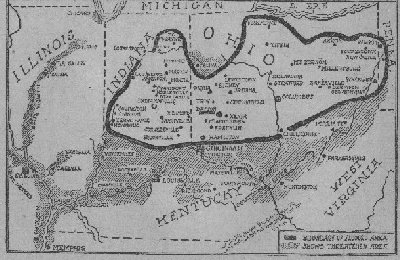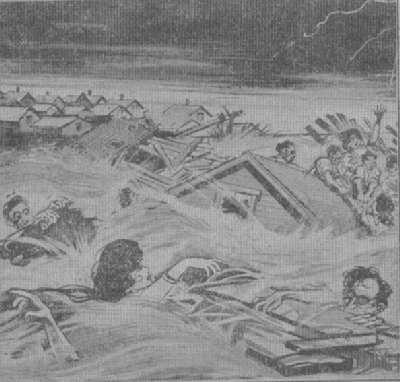A NATIONAL CALAMITY
A calamity which for the time being could only be measured in death and destruction by the horrors and devastation of war overtook a goodly portion of the states of Ohio and Indiana on Tuesday, March 25, 1913. Floods swept practically all the river towns of the two states and fire added its ravages in some of the flooded cities.
The chief arena of desolation noted in the first reports, was the beautiful city of Dayton, Ohio, where several thousand were at first reported dead. Scores of thousands were said to be homeless throughout the state of Ohio and the dead in the entire state, according to early estimates, reached appalling figures; but these estimates were based upon meager and fragmentary reports which later proved to be unfounded.
All through the night that followed, panic-stricken refugees were reported to be fleeing from the lowlands to places of greater comparative safety. The property loss was first estimated to be more than $100,000,000 and at least $5,000,000 was said to be required immediately to succor the homeless. An appeal to the outside world for aid was promptly issued.

These reports, greeting the eye of the American citizen at his breakfast table on Wednesday morning, March 26, effectually roused him from all semblance of apathy and transformed him into an efficient agency of practical sympathy for the afflicted cities of the great Middle West.
Then there followed a nation-wide quest for the facts of the great flood, and within a few hours the crippled telegraph and telephone services brought messages of confirmation from the state capital of Ohio, as follows:
"The Middle West is today in the grasp of the worst floods ever experienced, following in the wake of the terrific war of the elements which, in the past two days, has swept practically the entire country from Nebraska to Vermont.
"The State of Ohio, from the Maumee to the Ohio, is practically a vast inland lake, and the wildest rumors concerning the fate of the city of Dayton, one of the show places of the state, are afloat.
"A levee restraining the Miami River at Dayton broke during Tuesday morning and SOOfl the city was flooded to a depth of from seven to twelve feet. Many buildings had collapsed when the final link of communication with the outside world—one telephone wire— was lost.
"Up to 6 o’clock last night reliable reports placed the number of drowned there at sixty, but from that hour rumors of greater and almost unbelievable disaster began to trickle in from remote sources.
"A reservoir near Lewiston was reported to have broken and sent further flood upon the stricken city. Another report was to the effect that 5,000 persons had lost their lives and that the city had been engulfed by water to a depth of forty feet.
"Another rumor, equally lacking confirmation, was that the bodies of people could be seen being washed about in the streets and on the outskirts of Dayton.
"A report received via Anderson, Ind., says that the city of Celina, Ohio, has been engulfed by the breaking of the dam at the Grand Reservoir, and that the loss of life will total more than five hundred. The Grand Reservoir is a great lake, several miles in extent, which was located just to the east of the city, and its waters were held in check by a huge dam. The breaking of this dam would sweep the city just as Johnstown was swept when the dam broke there.
"From Hamilton, Ohio, comes a report that the flood had taken a toll of 1,000 lives.
"From Piqua, Ohio, comes another report that the loss of life in the floods in that city will reach five hundred.
"From Peru, Ind., comes a midnight message that 200 persons have been drowned in the floods there.
"All these reports are entirely without confirmation.
"From every city and town in Ohio with which communication is still possible a tale of death and disaster is reported."
Following these early reports which caused consternation and then awakened sympathy all over the United States, there gradually trickled over the wires from the stricken cities calmer and more accurate statements of actual conditions, but even these proved sad enough.
A large part of the city of Dayton had been overwhelmed by the rushing waters; its business section, residential districts and suburbs were all in the grip of the deluge; scores of men, women and children, though fortunately not hundreds, were drowned; thousands were indeed homeless, and enormous damage had been done.
Death and damage dealing flood conditions also prevailed in the Ohio cities of Cincinnati, Cleveland, Piqua, Hamilton, Delaware, Sidney and other towns and villages, which reported loss of life or great damage to property.
In the state of Indiana similar conditions were reported from Terre Haute, Peru, Shelbyville, Kokomo, Richmond, Marion, Ellwood, Lafayette and other places.
In all these cities and towns the condition of many homeless refugees was reported to be pitiable in the extreme and prompt measures were taken to rush relief to them, including food, clothing and medical supplies, with doctors and nurses to care for the sick and injured.
The Miami River enters the city of Dayton from the north and runs due south between the residential districts of North Dayton and Riverdale; then turns sharply west and after running west for a short distance again turns abruptly to the south. An important part of the city thus lies just inside the loop formed by the sharp bends of the river, into which several small tributaries empty their waters.

The fatal failure of the levees relied on to restrain the river within bounds, apparently occurred on the left side of the river just before it is joined by the Mad River. The water poured over the left wall into Third Street, and fifteen minutes later into Main Street, until the principal streets, which had hitherto never been thought in danger, were under 10 feet of water.
Many of the buildings on the sides of the river had been rendered so insecure by the rising waters that they left their foundations within an hour after the break came. In one district, what had been blocks of thickly populated one and two-story residences, occupied mostly by people of the Latin races, were at the mercy of the flood. Many of these small houses were torn from their foundations and heaps of ruins and shattered lumber were left to tell the tale of the flood’s fury.
Continue
Back
Back to Legacy
© 2001, Lynn Waterman